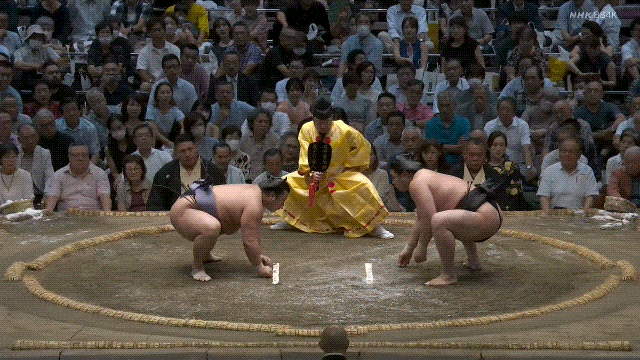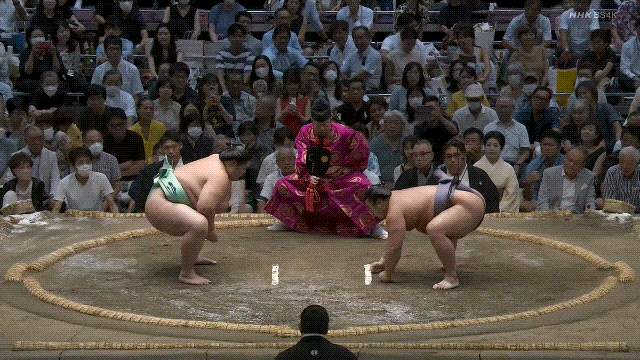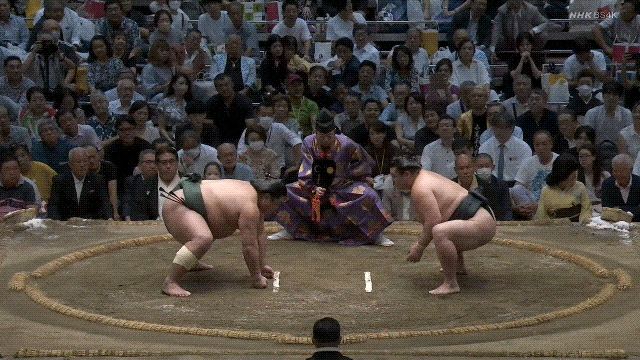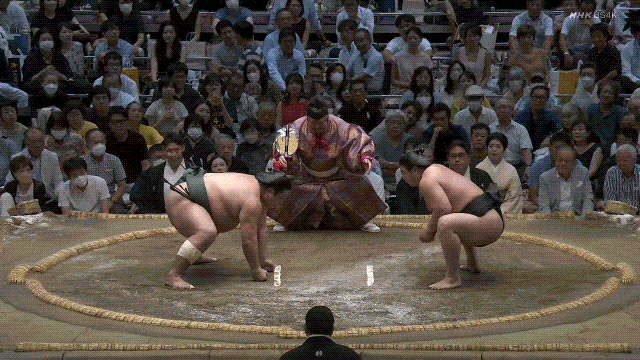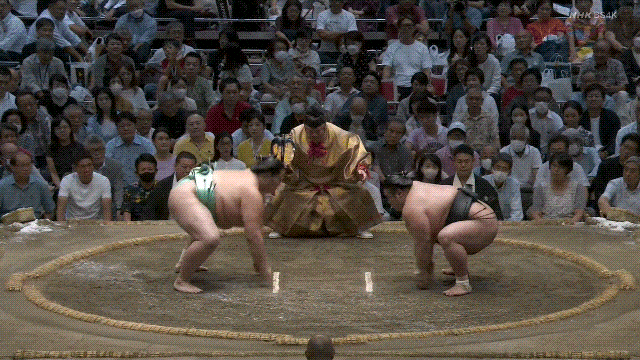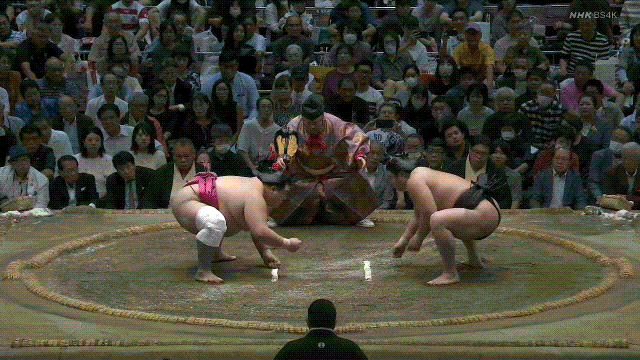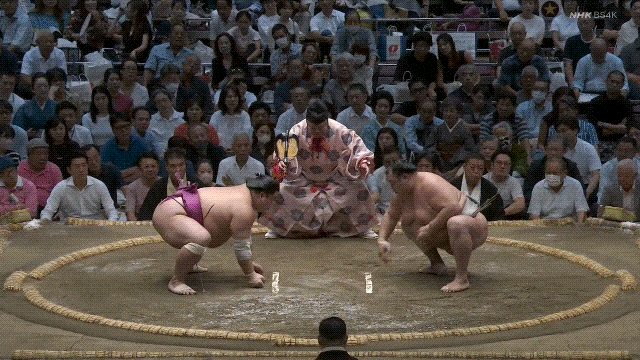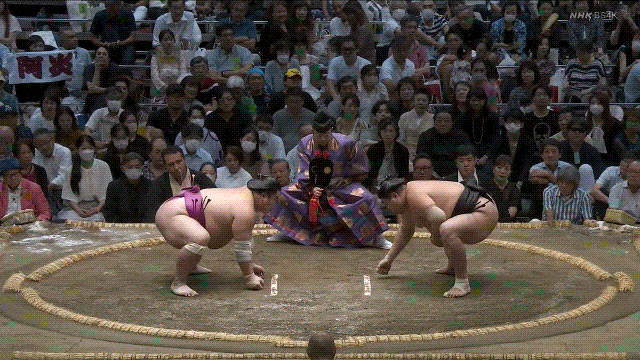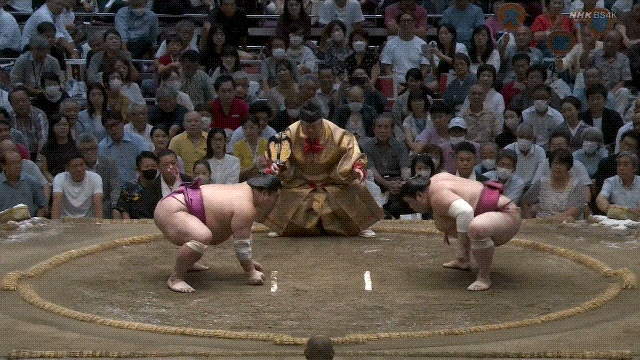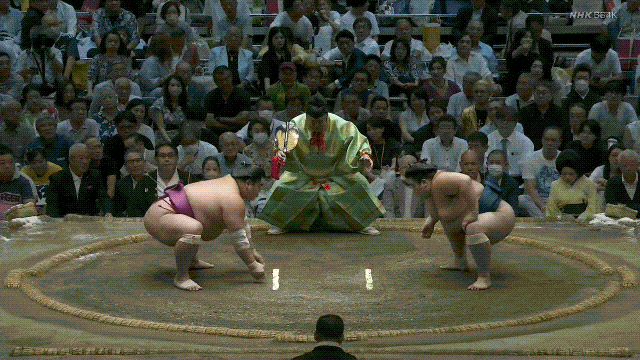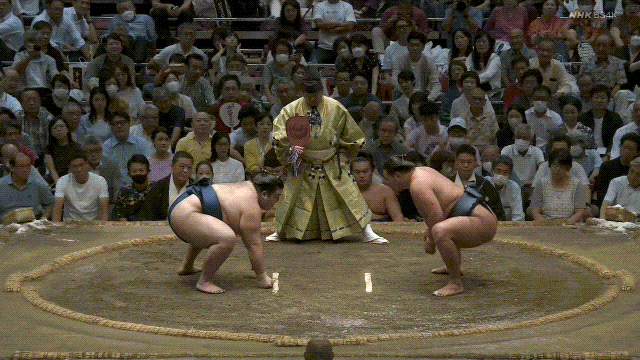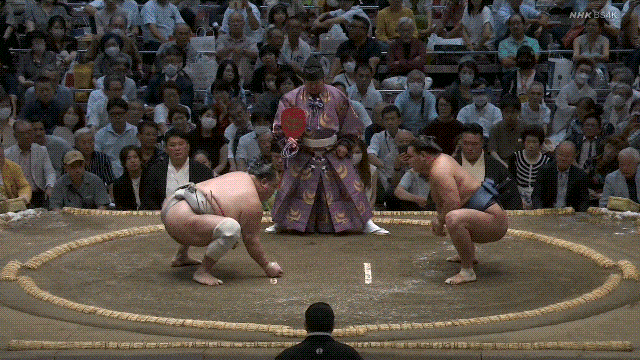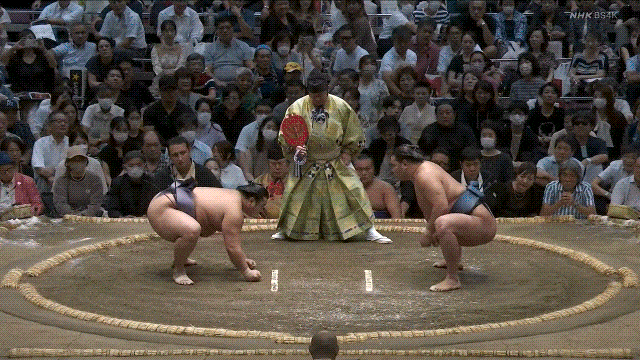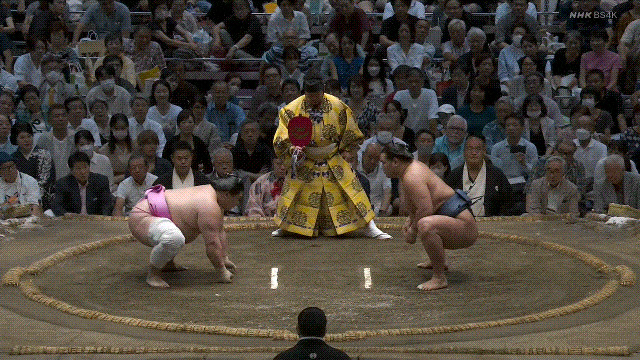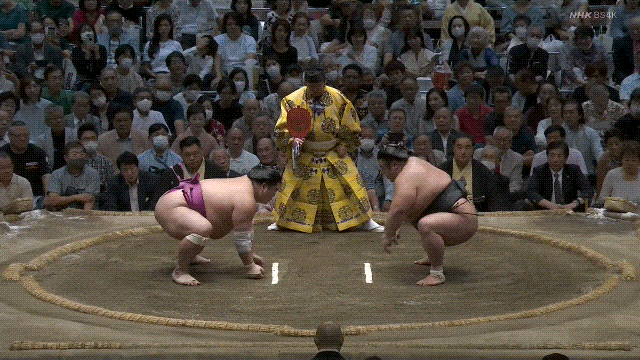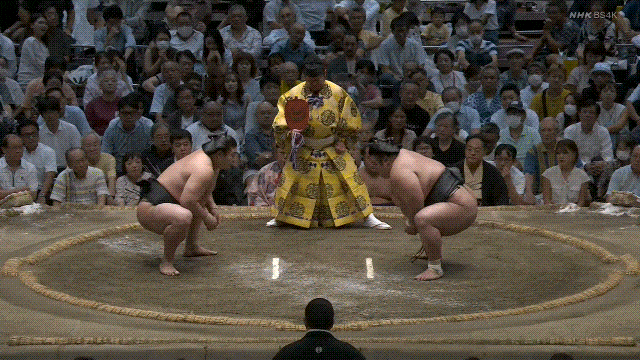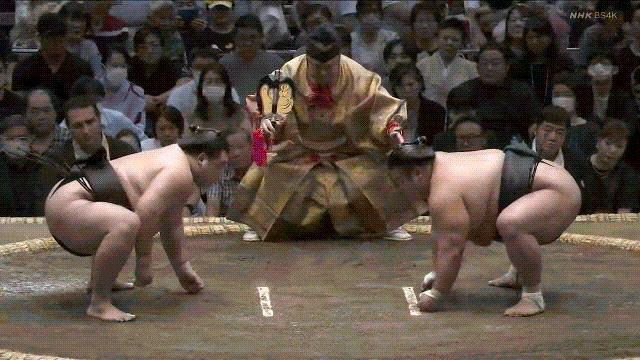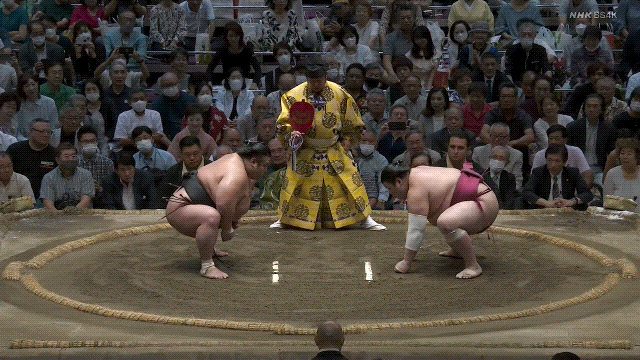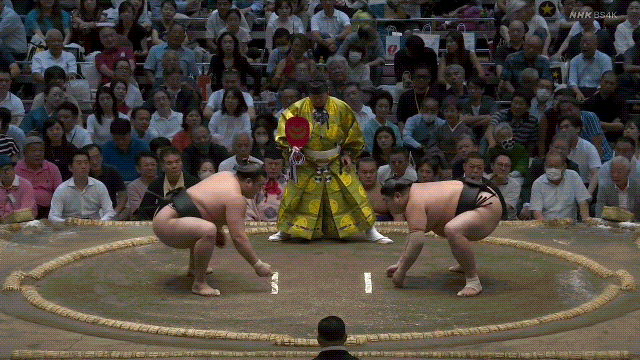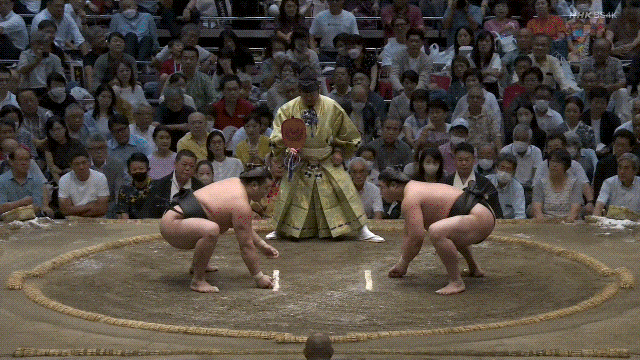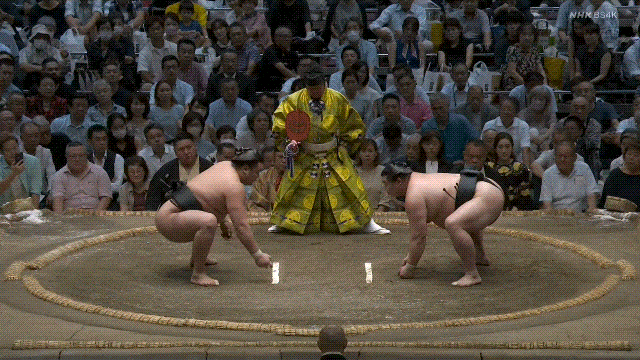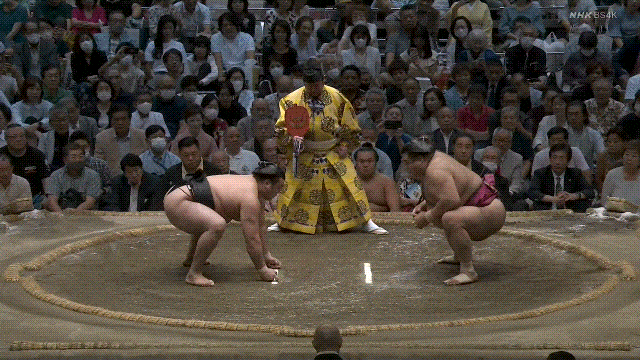This is a free preview of the Sumo Stomp! Substack. For in-depth analysis of sumo, and notifications for when sumo content appears on Bloody Elbow, subscribe today!
Jump to
Well, I wasn’t able to get this in there before the banzuke came out for Kyushu. Just had too much on my plate over the last week. It’s all good, though. We still have some time before the big boys head back to the dohyo for the final basho of the year.
But before we see them all do battle again, let’s just do a quick recap on how the upper ranked rikishi did last time out, at the Autumn Tournament. This is my last report card post for the aki basho, so it will be concerned with the upper rankers only. This group includes our winner and some fighters who under-performed in spite of their rank.
Let’s get into it.
Sumo Report Card: 2023 aki basho
Tobizaru
Rank: Komusubi west
Record: 6-9
Grade: C
Tobizaru was his usual frantic, chaotic and sometimes effective self in September. He was very fun to watch, as always, but this time out that did not translate into enough wins to secure the kachi-koshi.
At this point in his career, it’s pretty obvious that Tobizaru’s ceiling is komusubi and that he is just going to bounce between that ranking and high maegashira until age and/or injuries start to take their toll.
If nothing else he’s a great measuring stick to determine contenders from pretenders. He’s shown this year that he can beat anyone on his day and that you have to take him seriously, even if he’s such a joker outside of the ring.
At 31 he still has lots of speed and strength to win via conventional methods. But what makes him so unique, and special, is that he has a mind for the spectacular and bizarre that really only Ura can match (and I think Tobizaru’s bag of tricks is a little deeper than his).
Whereas Ura’s creativity flows when his body is in contact with his opposition, Tobizaru’s is more focused on what he does when he has separation from his opponent.
He loves to side-step, duck under, hop and leap to find angles and escape danger. A lot of the times he will over shoot, though, and land back in danger. This is why so many of his bouts end in close-calls.
See below how he was able to get exactly what he wants out of Wakamotoharu, but still fail to win. He finds separation (not easy versus Wakamotoharu) and then slides out to the side as his opponent is lurching forwards. Tobizaru played for this position, even though it leaves a lot up to luck. In this instance, luck wasn’t on his side.
Tobizaru was more controlled in some other matches, though. Here he is against new sekiwake Kotonowaka, showing an elusiveness that is unrivalled in all of sumo.
Wins over top guys (Hoshoryu, Meisei and Takakeisho) and entertainment value mean I can’t grade him too harshly for his 6-9 record.
Nishikigi
Rank: Komusubi east
Record: 5-10
Grade: E
This was tough to watch for Nishikigi. He tore his calf days before the tournament and it was pretty obvious that he couldn’t compete anywhere near to the best of his abilities.
In July he scored a 10-5 record and looked immovable at times. This time around, he just did not have the power he needed in that injured leg to put on the brakes or drive forwards.
That’s clear as day in his bout with Shodai.
… And Wakamotoharu.
A lower body injury is about the worst thing that can happen to Nishikigi for his brand of sumo. Hopefully it’s healed up enough now and we get to see him operate closer to the level that saw him win 14 bouts in a row across two tournaments earlier this year.
Kotonowaka
Rank: Sekiwake 2 east
Record: 9-6
Grade: B+
This was another successful showing for the 25-year-old. It was a quiet 9-6, though. Kotonowaka is such an under-the-radar talent that sometimes I forget he’s up near the top of the standings in a given tournament. I think it has something to do with how much control he has over his large, but pretty well balanced, body. In both winning and losing, we rarely see Kotonowaka spill into the crowd or land and roll awkwardly in the ring. That lack of highlight reel footage might be why I sometimes have to work hard to remember what he did in a given tournament.
I don’t want to take away from what he’s accomplishing, though. I do think he’s a very good wrestler and someone with a physical profile that can cause nightmares for just about everyone.
I think he might lack a little in aggression. The real pitbulls of the division seem able to back him down with their intensity, like what Takakeisho does below. Daieisho and Hokutofuji also scored wins off him in September.
Despite losing to those guys, though, Kotonowaka’s maiden sekiwake campaign has to go down as a big success. I feel like he could be ozeki material and quietly go on a run of double-digit victories next year.
Wakamotoharu
Rank: Sekiwake 1 west
Record: 9-6
Grade: B
Back to back 9-6 records for Wakamotoharu have him stalling out a bit in his campaign to become an ozeki. I wonder if he was suffering a bit of a hangover in this tournament after he lost his shot at ozeki in July.
I felt like Wakamotoharu continued with a more measured sumo in September, again eschewing the high risk (and back wrenching) pivoting/throwing techniques and just trying to keep it simple (and effective).
Much of his bouts looked like this one against Onosho. Strong thrusts on route to a solid grip and then beautiful foot-skimming advances to force someone out. Seven of his nine wins were yorikiri in September. He also got an oshidashi on Tobizaru (which we looked at above) and a hatakikomi on the hapless Tamawashi.
I like this style for Wakamotoharu when it comes to longevity and sustained success in the sekiwake and komusubi ranks. If he is serious about being an ozeki, though, he might need a little more craft and creativity in his game.
Daieisho
Rank: Sekiwake 1 east
Record: 10-5
Grade: A-
I enjoyed watching Daieisho at the aki basho. This is after I’ve railed against him for being one dimensional most of the year. He’s still a little one-note, but in September he found some ways to bend that note and make his sumo more interesting and harder to predict.
His straight on pushing is still so good that he doesn’t need to adapt much of the time. He’s excellent at hitting hard in the tachiai, forcing someone backwards and then getting them to arch backwards.
See how once Hokutofuji is arching back it’s all over.
That’s a live by the sword, die by the sword approach, though. Look what happens when Abi is able to get Daieisho arching back.
Daieisho was able to show some slick moves against other aggressive pushers, though. He showed youngsters Atamifuji and Gonoyama a thing or two about oshi-zumo.
Watch him handle both those young pups below. He shoves them back, feels their strength, reads their advances and then sends them down.
I rarely see Daieisho fight this way against more established talent. Maybe he felt liberated a little since his opponents were younger and maybe more ‘deserving’ of some trickery. I wish he’d do this against his fellow upper-ranked fighters more often, though, instead of just trying to plow them back and out each time.
Hoshoryu
Rank: Ozeki 2 west
Record: 8-7
Grade: C
I was dead wrong about Hoshoryu.
I went on record stating that he had the mental chops to immediately rise to the occasion of the ozeki rank and not let the pressure of the position affect him. My evidence for this was his cool handling of Hokutofuji and Hakuoho in the must-win matches that lead to his first ever yusho in July.
However, it was pretty clear that Hoshoryu was feeling the ozeki jitters in his first tournament since that lofty promotion. There’s nothing wrong with that. I was just assuming he would was too plucky, and too good, to care about such a thing.
I guess he’s human after all. That’s a bit of a relief, really.
What’s important, though, is that after his shaky first half of the tournament he was able to rally and rescue a winning record, with wins over Takakeisho and Hokuseiho.
I do think he was a little lucky to find himself in that position, though. Many of his wins earlier in the tournament were very close bang-bang finishes where he hit the ground just after his opponent.
This win over Gonoyama is one of those:
I think Hoshoryu was feeling like he needed to win early in the tournament and do so with authority. It seemed like he was over-committing to early maneuvers that he thought would get him quick victories. That goes against type for him, though.
Hoshoryu is at his best when he is reacting to what his opponent is giving him, but here against Hokutofuji, Ura and Tobizaru he doesn’t give them a chance to create anything for him to counter. He just puts his head down and tries to push them out.
Despite these losses Hoshoryu is still a generational talent. I still have full confidence in him becoming a yokozuna. When that happens we won’t remember this shaky (but still winning) tournament. In the latter half of the basho he looked more like his old self, anyway, particularly with his heady watashikomi win over Hokuseiho to claim his eighth win.
With his jitters out the way, I think we’ll see a Hoshoryu that hits double-digit wins in Kyushu.
Takakeisho
Rank: Ozeki 1 west
Record: 11-4 (yusho)
Grade: A+
Relentless. Frightening. Composed.
Those are the words I put in my notes while watching Takakeisho in September. This was the same Takakeisho we saw in January, which prompted debate about a yokozuna promotion. He’d probably have that promotion now if he’d performed like this all year and wasn’t sidetracked by multiple knee injuries.
Because of those injuries, we are back where we were at the end of January, arguing whether or not Keisho deserves the top rank and mostly agreeing that the Angry Hamster still needs to do more. If he can win his third championship of the year (and his second in a row) in Kyushu, that should be enough to make him the 74th yokozuna.
His aki basho ended with a title and some controversy. We’ll get to that, but first let’s look at how incredible Takakeisho was in his winning efforts throughout the tournament.
Look at his offense versus Daieisho on the final day of the tournament. Pay attention to his feet. Takakeisho is so good at making very small adjustments with his feet that allow him to drive with power every other second. He hits, resets, hits, resets, hits and eventually gets Daieisho (the second best pusher in the game behind Takakeisho) to the edge and out.
His footwork is excellent when it comes to lateral movements, too. Look at the mobility he shows circling around Wakamotoharu to chase him to the edge and finish with a swipe that must be a lot stronger than it looks.
His footwork in defense was on full display versus Meisei. Meisei backs him down, but as he moves backwards, Takakeisho is constantly resetting his feet and getting himself in position to mitigate and brace for impact. See the little step forwards after the steps back? That keeps him, literally, on the front foot, despite being moved backwards. Then, he switches stance, to change the target area for Meisei’s push, making Meisei have to reach farther out and over-extend himself. Meisei, who is all upper body and little lower body, gets caught flat footed. Takakeisho can just step back to score the win.
Because Takakeisho has this in his game, I can not only forgive his henka, but salute it wholeheartedly. He can win pushing forwards, he can win while being pushed back and he can with a henka. And winning is what we’re here for.
I can understand getting mad at a one-trick pony for winning a title with a henka, but when Takakeisho blasts through Daieisho on the final day to set up a play-off with Atamifuji (who he blasted through earlier in the tournament), I think the henka was the ideal move. Atamifuji was expecting a forward charge, like he felt last time they met, so why not switch it up? It’s on the rookie to not make assumptions and to be ready to attack again when he realizes his opponent is not there. It’s not on Takakeisho to make things easier for his opponent.
Yokozuna sumo is winning sumo and that’s exactly what Takakeisho is doing. And he’s winning in ways where he can save some wear and tear on his knees, allowing him to be a dominant pushing presence for the majority of his matches. A henka here and there is nothing to sniff at and it might be what gives us the chance to see another yokozuna on the scene sooner rather than later.
Kirishima
Rank: Ozeki 1 east
Record: 9-6
Grade: C+
This was a bit of a weird basho for Kirishima. At times he looked stellar, as he did earlier in the year. At other times he fell to rash decisions and looked rather average.
See how Abi beat him up like he was a rank-and-filer, below. Kirishima is one of the smartest wrestlers on the circuit and it’s a little baffling that would play right into Abi’s game like this.
He also looked average when getting squashed by Wakamotoharu (who may be benefiting from how much time these two spend cross-training out of competition).
But despite those kinds of losses, there were flashes of the best version of Kirishima. We saw that when Shodai got ahead of steam and Kirishima was able to circle around half the ring before pulling off an emphatic throw.
And we saw his elite elusiveness and ring awareness against Takayasu. Like Hoshoryu, Kirishima is a master at feeling the push and pull of a match and knowing when he can pounce (or eject) in order to score a win. Whereas Hoshoryu’s wins in that moment are most often throws, Kirishima is a little more deft. He has plenty of throws in his locker, but he can also get wins with a subtle side step or slap down in ways Hoshoryu rarely does.
9-6 isn’t a bad record for Kirishima here, but I expected more. Maybe he was still a little banged up after his injury at the last tournament. Either way, though, I’m excited to see both he and Hoshoryu hit a grove at ozeki and join the battle for yokozuna promotion.
Terunofuji
Rank: Yokozuna
Record: 0-0-15
Grade: Ungraded
Another sit-out for the yokozuna. This time due to back problems, apparently. His 1-3-11 in July and 0-0-15 have really sapped my optimism over what the big man has left in the tank. His championship in May was a fairy-tale moment, but that triumphant return is now starting to look like a last hurrah.
So there you have it, our aki basho rankings are in the books. Anything here you disagree with? If so, I’d love to chat about it in the comments.
The next thing you’ll get from me will probably be a link to my Kyushu Basho preview post on BloodyElbow.com. I may also be appearing on one of our podcasts at BE to talk sumo and the forthcoming tournament.
Hope you enjoy those and thank you so much for reading these report cards.
For more sumo content please subscribe to Sumo Stomp! on Substack. Whether you are a veteran fan or someone who is looking to get into the sport, Sumo Stomp! has you covered with news, explainers, tournament updates and technical analysis.

Join Sumo Stomp!
Subscribe to the Substack!
About the author


